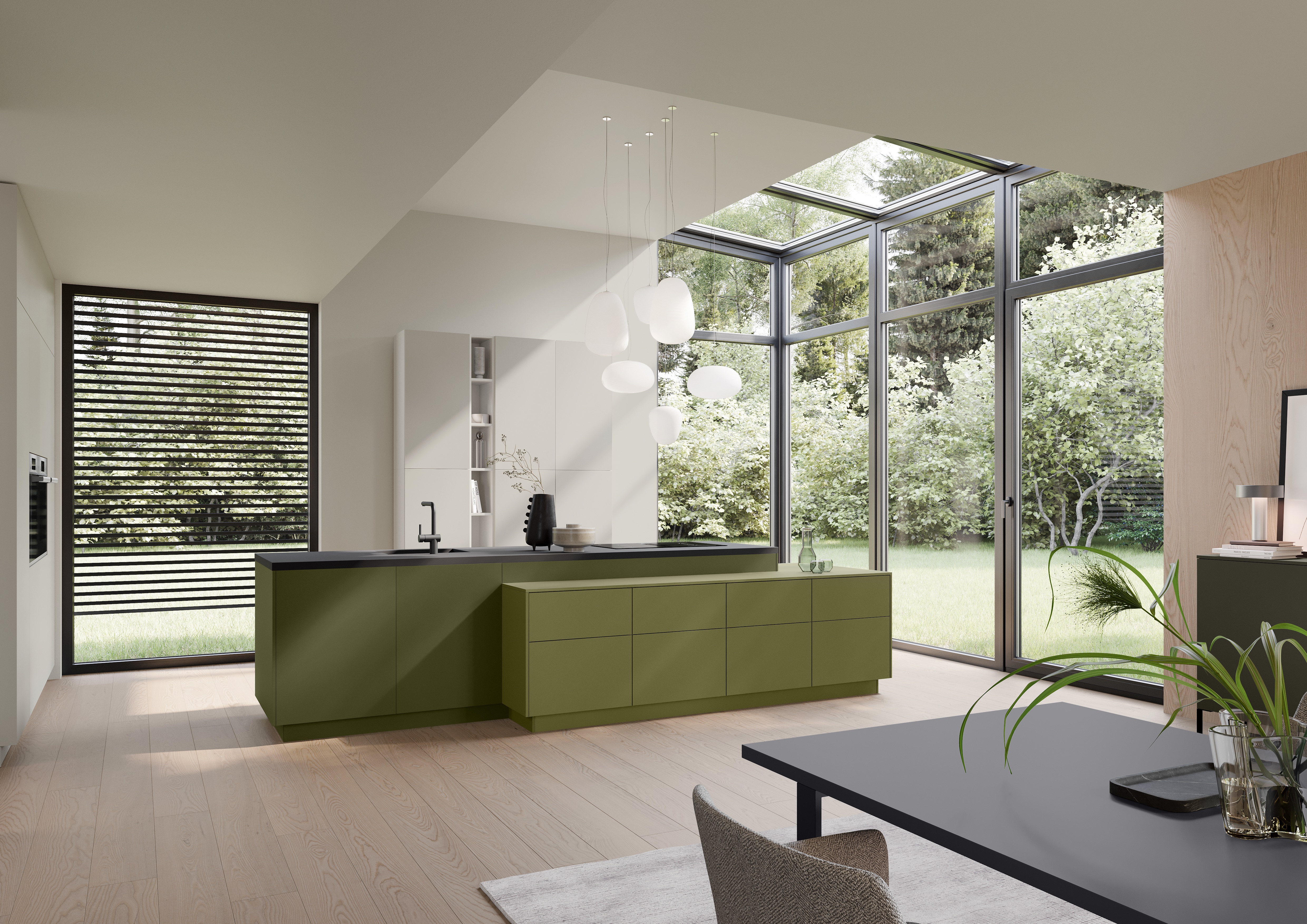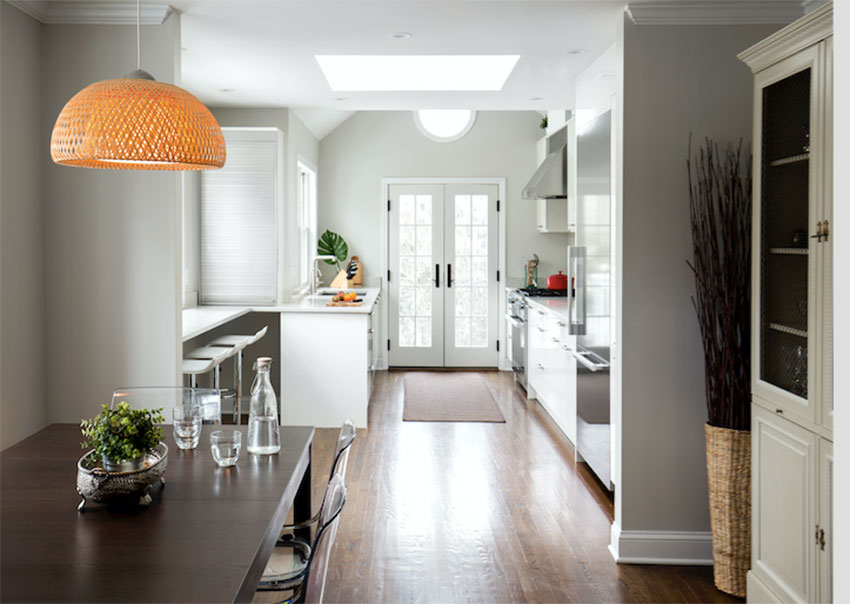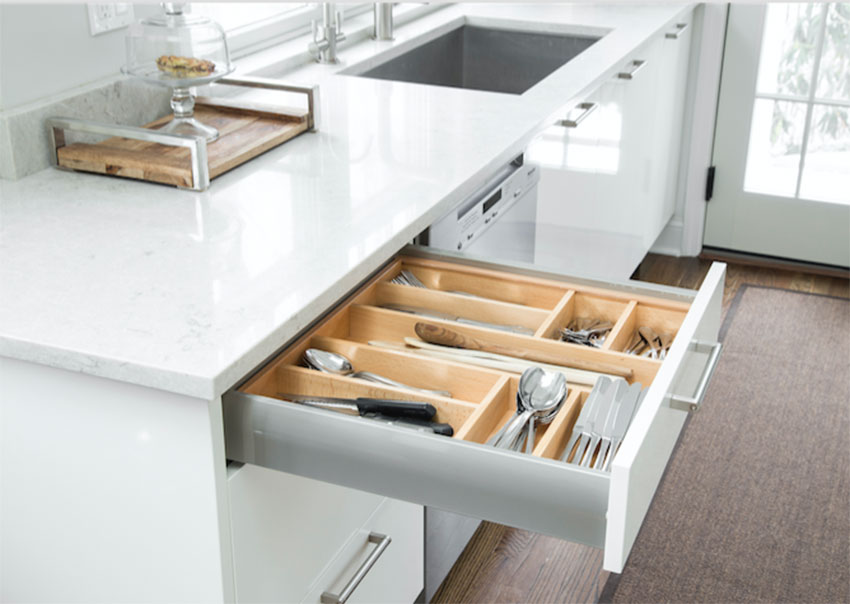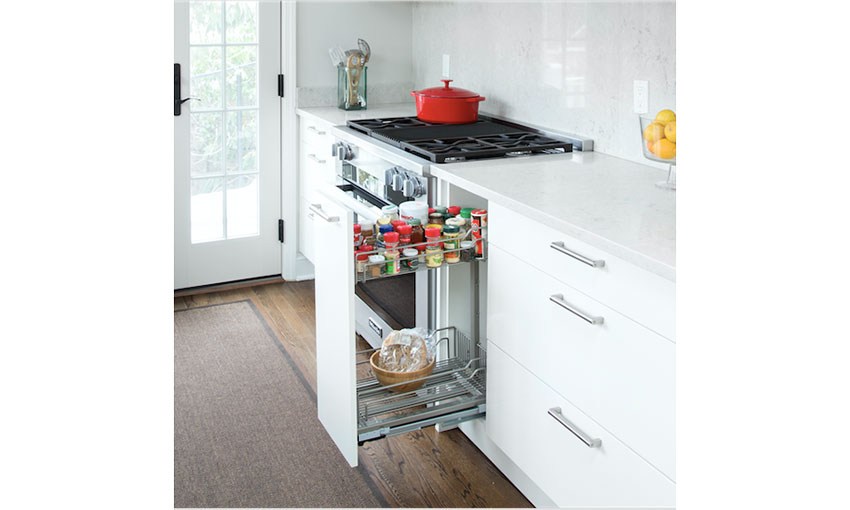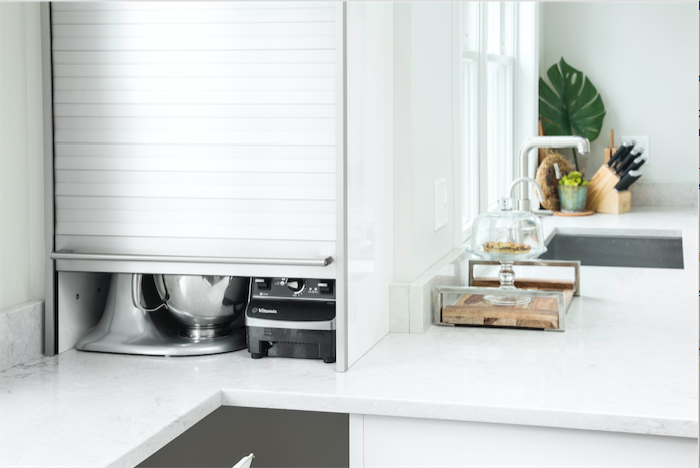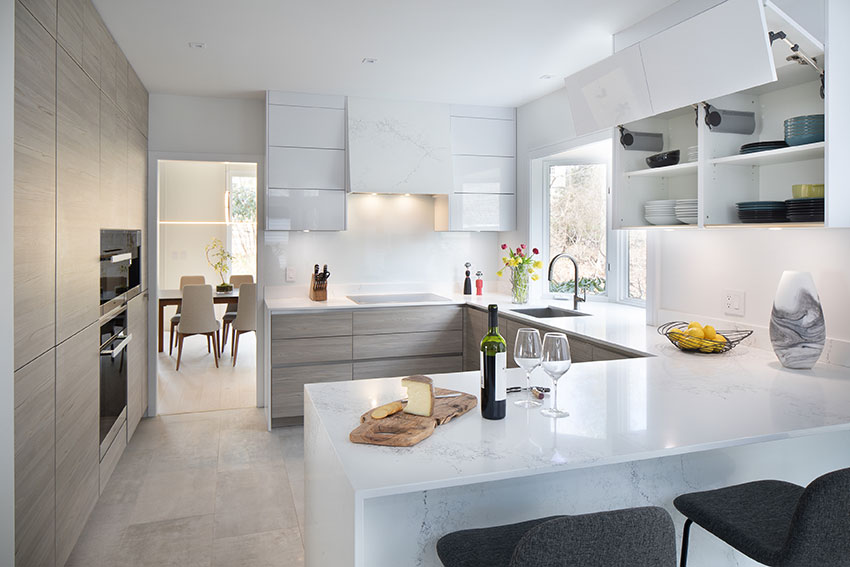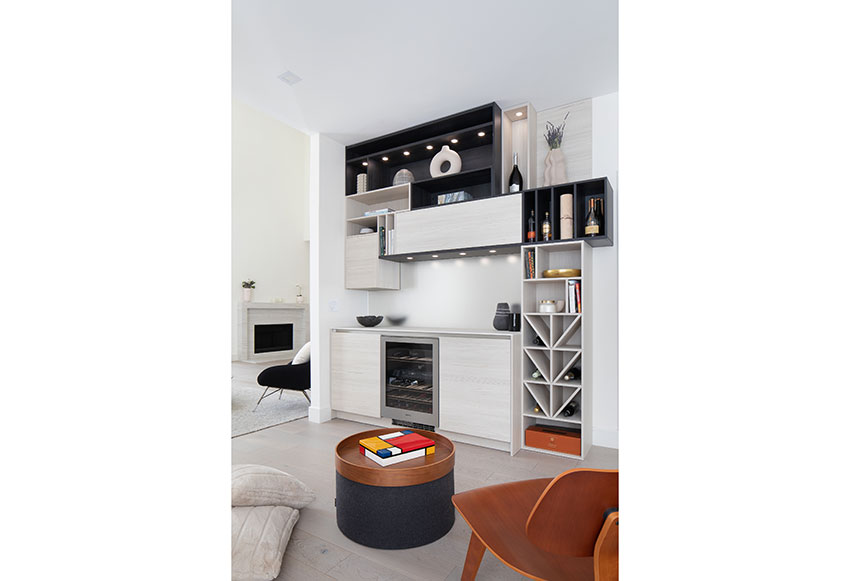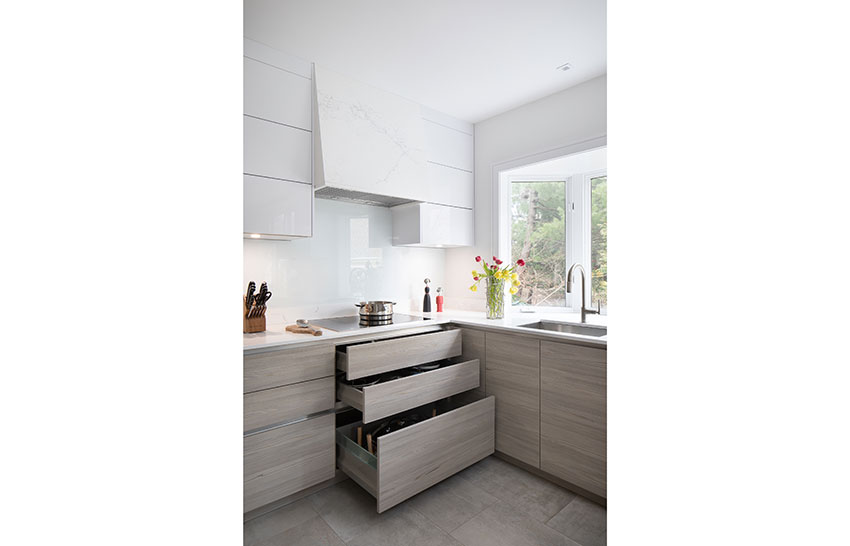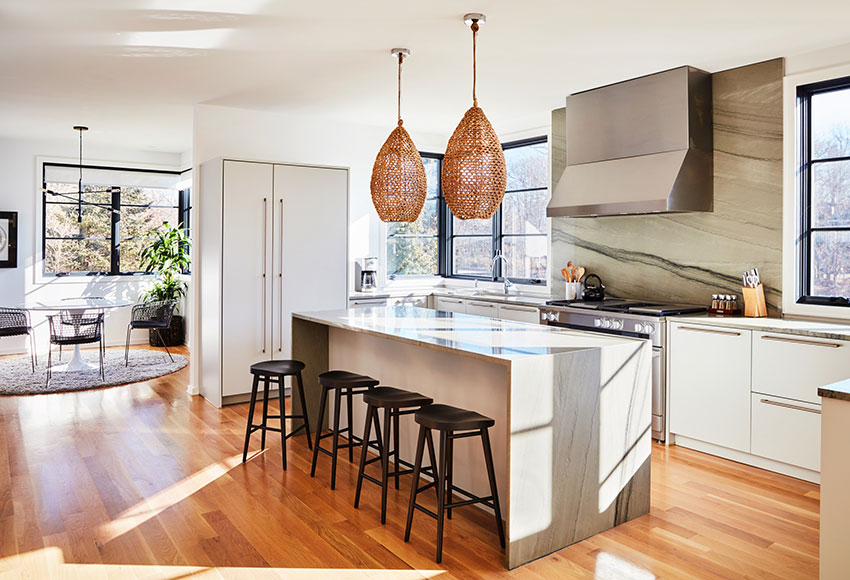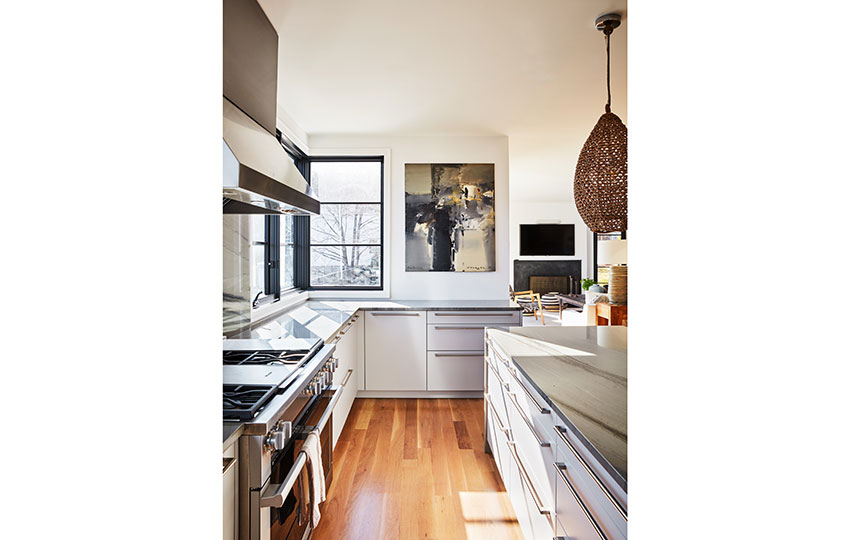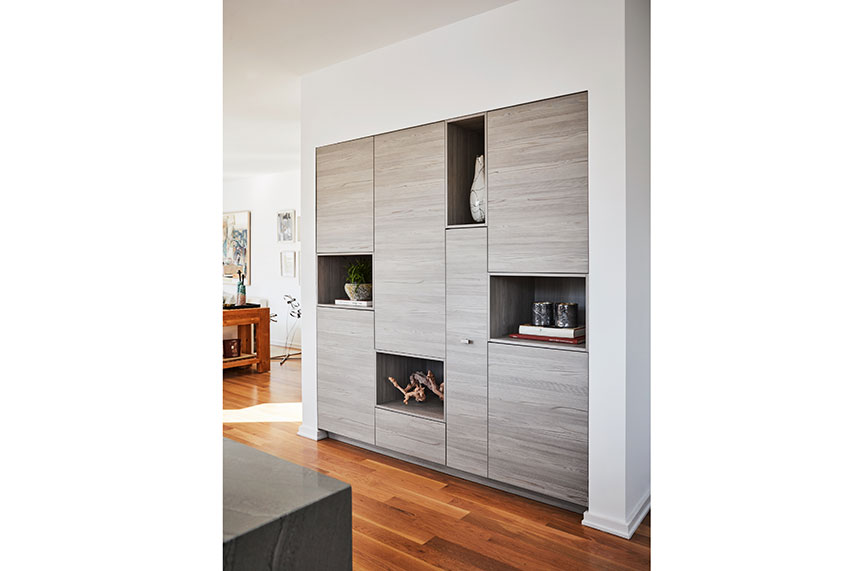A serene and orderly home is critical for the health, safety, and well-being of today’s homeowners. A well-ordered and functional kitchen is key to achieving that goal. No matter how elevated the aesthetic of the kitchen, it cannot be considered a success unless the client has organizational strategies to make the kitchen a functional space, customized to their needs. This course reflects on the dangers of a non-orderly home and kitchen, touches on the benefits of orderly spaces, and launches into a robust examination of the myriad ways drawers and cabinets can reach their highest potential with innovative, forward-thinking organizational products. Three case studies bring these principles to life.
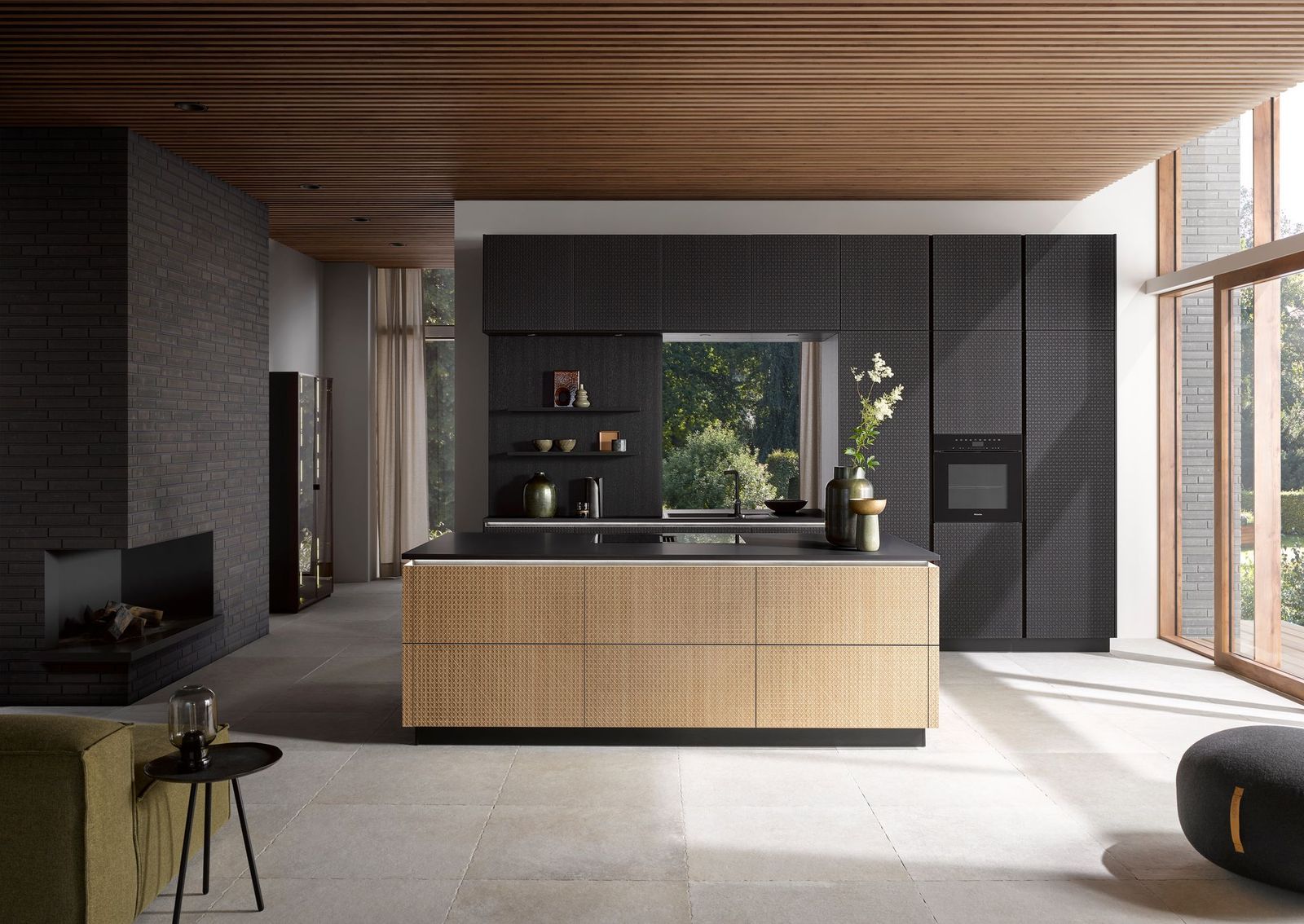
All photos courtesy of Häcker Kitchens
An organized, clutter-free kitchen adds to household harmony.
AN ORGANIZED HOME LEADS TO OCCUPANTS' HEALTH, SAFETY, AND WELL-BEING
For designers, the kitchen is by far the most complex room in the house. But the stakes are high to get it right. Where is orderly tranquility more vital than the heart of the home? A well-ordered kitchen requires intricate coordination between appliances, surfaces, storage, lighting, plumbing, fixtures, power, ventilation, and aesthetics. Depending on the designer’s attention to the client’s needs, a kitchen can be calming or confusing. It can make cooking enjoyable or exasperating. The organizational features in a kitchen can be highly sophisticated or they can be virtually nonexistent.
With the specification of innovative, forward-thinking kitchen organization strategies, designers can transform this key space into the most functional and least stress-inducing room in the house. We’ll begin with the consequences of a disordered kitchen and home, the benefits of orderly spaces, and ways to achieve an orderly kitchen.
Consequences of a Disordered Kitchen
A disordered kitchen is caused by two factors: visible clutter and hidden clutter. Both can have negative impacts on mental health.
The health effects of clutter are listed in an article on the award-winning WebMD website.1 They include:
- A wandering mind that makes it hard to focus on important tasks when several things compete for attention. Researchers have found that being around disorganization makes it harder for a brain to focus.
- Stress is created in the body when clutter occurs. Studies show that women who saw their homes as cluttered produced higher levels of the stress hormone cortisol.
- Isolation can occur when people with cluttered homes hesitate to invite people over, leading to feelings of loneliness.
- Safety can be an issue in cluttered spaces.
- Weight gain can happen around clutter and hoarding. According to the article, one study found that “as hoarding got worse, so did body mass index (BMI) and binge-eating symptoms (eating large amounts of food in a short time).”
While women suffer more from a cluttered home than do men, older people suffer more than younger people. However, according to a recent study, both genders and age groups suffer from cluttered environments.2
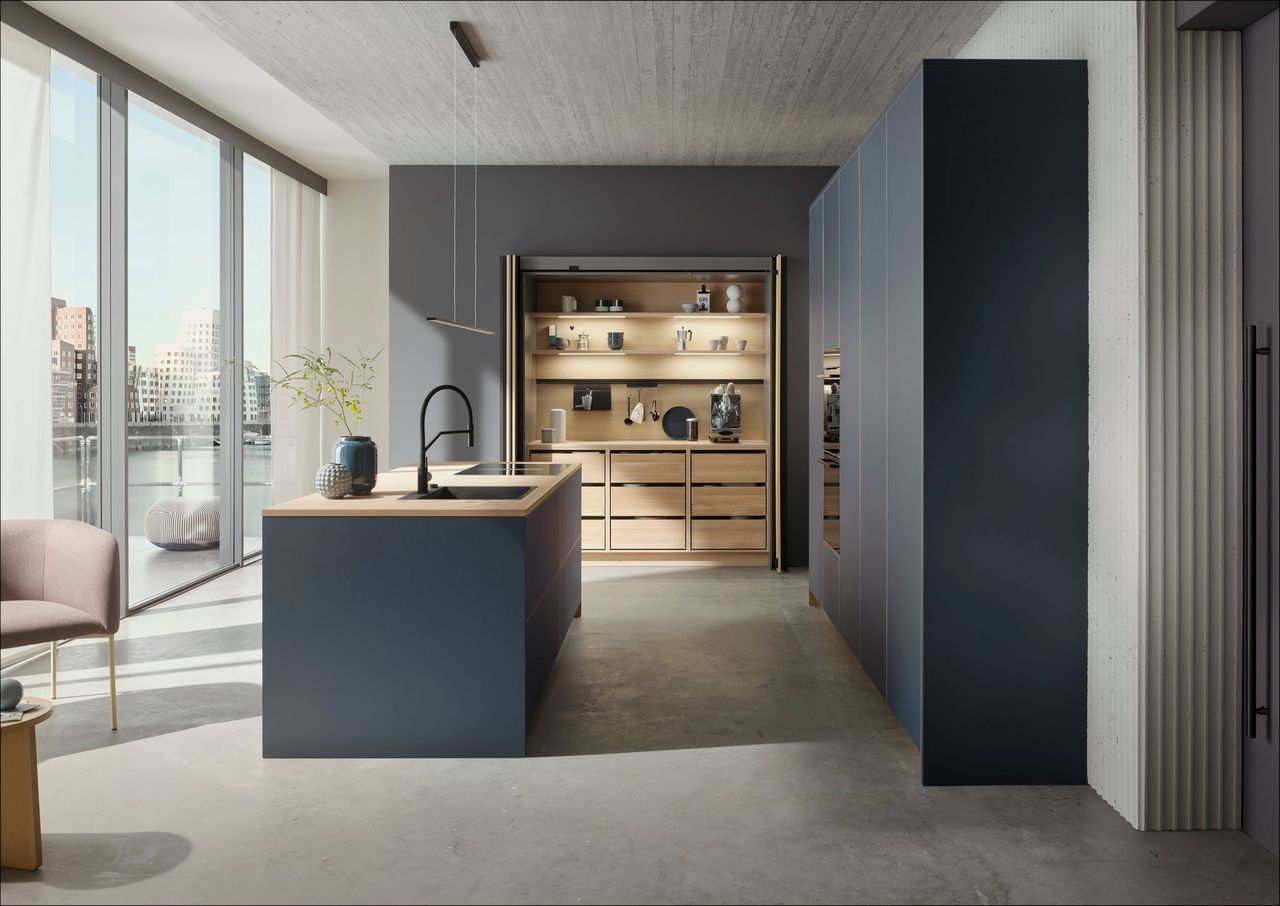
A well-ordered kitchen involves innovative storage strategies in the cabinets and drawers, as well as display shelves with sophisticated lighting.
Benefits of a Well-Ordered Home and Kitchen
The benefits of an organized home and kitchen are the opposites of the negative consequences of a cluttered space. Concentration improves, stress lessens, and safety increases. Well-ordered, non-cluttered spaces also provides these benefits:
- Saves time—When every item has a place, less time is used looking for lost or misplaced items.
- Maintains harmony—In a well-ordered kitchen and home, there is likely to be fewer arguments about lost items.
- Increases ergonomics—A thoughtfully designed kitchen is easier for clients to use without undue strain. Think of a client using a sophisticated swinging shelf in a cabinet corner, rather than the client searching on hands and knees for an item tucked into a dark recess.
- Contributes to aging in place—The more a kitchen functions smoothly, the more likely an aging occupant can continue using that kitchen.
Trends in Kitchen Design Point to Need for Organization
Recent design trends emphasize the growing demand for organization and efficient use of space in the kitchen. According to the “2024 Q1 Home Design Trends Survey” by the American Institute of Architects, there has been a noticeable increase in the popularity of working pantries, coffee bars, and deep pull-out shelves, reflecting a shift toward kitchens designed with specific functional zones. The survey found that the desire for working pantries rose by 5 percent in 2023, underscoring the importance of dedicated storage areas that allow for better organization of food prep, storage, and clean-up tasks.
Additionally, features such as coffee bars and wine refrigerators have also seen a rise, signaling a preference for organized, dedicated spaces that minimize clutter and enhance the kitchen's functionality.
The trend also points to a growing need for efficient storage solutions and accessories that help reduce kitchen clutter while maximizing usable space. Deep pull-out shelves, for example, are becoming increasingly popular, with 36 percent of respondents reporting an uptick in their use. This highlights the importance of accessible, well-organized storage that allows for easy access to kitchen essentials while keeping countertops clean and tidy.
These trends indicate a clear shift toward kitchens that prioritize functionality and organization, with homeowners seeking ways to create more efficient workflows and maintain a clutter-free environment without sacrificing style or design. Home Design Trends Survey
Highly regarded kitchen companies understand and respond to customer desires. “We’ve reached a tipping point within the living kitchen trend where classic kitchen furnishings are being carried into the living room and other spaces,” said Andreas Gommeringer, president Häcker Kitchens North America. “The array of new launches is impressive, even for Häcker Kitchens. We have dramatically increased our options for on-trend personalization, all within a very accessible price point for designers and their customers.”
THE FACTORS OF A WELL-ORDERED KITCHEN
Designing a functional, non-cluttered kitchen requires a number of factors that must blend seamlessly. They are:
Placement
For a kitchen to be a highly functioning, stress-free environment, the layout is key. It must be situated in the right place in the house for the client’s needs, such as adjacent to the family room for entertaining, or near the garage for unloading groceries, or at the opposite end of the house from bedrooms for noise control. Within the kitchen space, the placement of the sink, stove, and refrigerator must contribute to ease in cooking.
Storage
The well-ordered kitchen needs ample storage space for items the client wants to store. Space must be allocated for dinnerware, cutlery, daily food, bulk food, cases of water, trash, recycling, etc. Innovative storage solutions for wine or a large pastry mixer or a collection of spices add up to a customized feeling.
A serene and orderly home is critical for the health, safety, and well-being of today’s homeowners. A well-ordered and functional kitchen is key to achieving that goal. No matter how elevated the aesthetic of the kitchen, it cannot be considered a success unless the client has organizational strategies to make the kitchen a functional space, customized to their needs. This course reflects on the dangers of a non-orderly home and kitchen, touches on the benefits of orderly spaces, and launches into a robust examination of the myriad ways drawers and cabinets can reach their highest potential with innovative, forward-thinking organizational products. Three case studies bring these principles to life.

All photos courtesy of Häcker Kitchens
An organized, clutter-free kitchen adds to household harmony.
AN ORGANIZED HOME LEADS TO OCCUPANTS' HEALTH, SAFETY, AND WELL-BEING
For designers, the kitchen is by far the most complex room in the house. But the stakes are high to get it right. Where is orderly tranquility more vital than the heart of the home? A well-ordered kitchen requires intricate coordination between appliances, surfaces, storage, lighting, plumbing, fixtures, power, ventilation, and aesthetics. Depending on the designer’s attention to the client’s needs, a kitchen can be calming or confusing. It can make cooking enjoyable or exasperating. The organizational features in a kitchen can be highly sophisticated or they can be virtually nonexistent.
With the specification of innovative, forward-thinking kitchen organization strategies, designers can transform this key space into the most functional and least stress-inducing room in the house. We’ll begin with the consequences of a disordered kitchen and home, the benefits of orderly spaces, and ways to achieve an orderly kitchen.
Consequences of a Disordered Kitchen
A disordered kitchen is caused by two factors: visible clutter and hidden clutter. Both can have negative impacts on mental health.
The health effects of clutter are listed in an article on the award-winning WebMD website.1 They include:
- A wandering mind that makes it hard to focus on important tasks when several things compete for attention. Researchers have found that being around disorganization makes it harder for a brain to focus.
- Stress is created in the body when clutter occurs. Studies show that women who saw their homes as cluttered produced higher levels of the stress hormone cortisol.
- Isolation can occur when people with cluttered homes hesitate to invite people over, leading to feelings of loneliness.
- Safety can be an issue in cluttered spaces.
- Weight gain can happen around clutter and hoarding. According to the article, one study found that “as hoarding got worse, so did body mass index (BMI) and binge-eating symptoms (eating large amounts of food in a short time).”
While women suffer more from a cluttered home than do men, older people suffer more than younger people. However, according to a recent study, both genders and age groups suffer from cluttered environments.2

A well-ordered kitchen involves innovative storage strategies in the cabinets and drawers, as well as display shelves with sophisticated lighting.
Benefits of a Well-Ordered Home and Kitchen
The benefits of an organized home and kitchen are the opposites of the negative consequences of a cluttered space. Concentration improves, stress lessens, and safety increases. Well-ordered, non-cluttered spaces also provides these benefits:
- Saves time—When every item has a place, less time is used looking for lost or misplaced items.
- Maintains harmony—In a well-ordered kitchen and home, there is likely to be fewer arguments about lost items.
- Increases ergonomics—A thoughtfully designed kitchen is easier for clients to use without undue strain. Think of a client using a sophisticated swinging shelf in a cabinet corner, rather than the client searching on hands and knees for an item tucked into a dark recess.
- Contributes to aging in place—The more a kitchen functions smoothly, the more likely an aging occupant can continue using that kitchen.
Trends in Kitchen Design Point to Need for Organization
Recent design trends emphasize the growing demand for organization and efficient use of space in the kitchen. According to the “2024 Q1 Home Design Trends Survey” by the American Institute of Architects, there has been a noticeable increase in the popularity of working pantries, coffee bars, and deep pull-out shelves, reflecting a shift toward kitchens designed with specific functional zones. The survey found that the desire for working pantries rose by 5 percent in 2023, underscoring the importance of dedicated storage areas that allow for better organization of food prep, storage, and clean-up tasks.
Additionally, features such as coffee bars and wine refrigerators have also seen a rise, signaling a preference for organized, dedicated spaces that minimize clutter and enhance the kitchen's functionality.
The trend also points to a growing need for efficient storage solutions and accessories that help reduce kitchen clutter while maximizing usable space. Deep pull-out shelves, for example, are becoming increasingly popular, with 36 percent of respondents reporting an uptick in their use. This highlights the importance of accessible, well-organized storage that allows for easy access to kitchen essentials while keeping countertops clean and tidy.
These trends indicate a clear shift toward kitchens that prioritize functionality and organization, with homeowners seeking ways to create more efficient workflows and maintain a clutter-free environment without sacrificing style or design. Home Design Trends Survey
Highly regarded kitchen companies understand and respond to customer desires. “We’ve reached a tipping point within the living kitchen trend where classic kitchen furnishings are being carried into the living room and other spaces,” said Andreas Gommeringer, president Häcker Kitchens North America. “The array of new launches is impressive, even for Häcker Kitchens. We have dramatically increased our options for on-trend personalization, all within a very accessible price point for designers and their customers.”
THE FACTORS OF A WELL-ORDERED KITCHEN
Designing a functional, non-cluttered kitchen requires a number of factors that must blend seamlessly. They are:
Placement
For a kitchen to be a highly functioning, stress-free environment, the layout is key. It must be situated in the right place in the house for the client’s needs, such as adjacent to the family room for entertaining, or near the garage for unloading groceries, or at the opposite end of the house from bedrooms for noise control. Within the kitchen space, the placement of the sink, stove, and refrigerator must contribute to ease in cooking.
Storage
The well-ordered kitchen needs ample storage space for items the client wants to store. Space must be allocated for dinnerware, cutlery, daily food, bulk food, cases of water, trash, recycling, etc. Innovative storage solutions for wine or a large pastry mixer or a collection of spices add up to a customized feeling.
Display
While unwanted clutter is absent in an orderly kitchen, that doesn’t mean the room is void of personality. Open shelves or glass-fronted cabinets can display meaningful items for the client’s enjoyment. Added lighting increases the visual impact.
Cleaning
A stress-free, organized kitchen should be easy to clean. That means lack of grout lines, finger-print resistant surfaces, etc. And there should be an organized way to store cleaning products, such as dedicated baskets under the sink.
Safety
An orderly kitchen offers a number of safety features, such as a dedicated storage solutions for sharp knives, a dedicated space for a fire extinguisher, and integrated child-proof locks for drawers and cabinet doors.
Waste and Recycling
A place for trash and recycling are not afterthoughts in an uncluttered kitchen. They have their own dedicated spaces.
Lighting
Finally, kitchen lighting is a key aspect of any intelligent kitchen design, and it will be presented here in more detail. Proper lighting can not only make a kitchen more functional, but it can also make it more inviting and welcoming. With the right lighting, a kitchen can be transformed into a space that is not only efficient for cooking and preparing meals, but also a place where friends and family can gather. Designer Tarek Dawood3 explains the various types of lighting to consider when designing a kitchen.
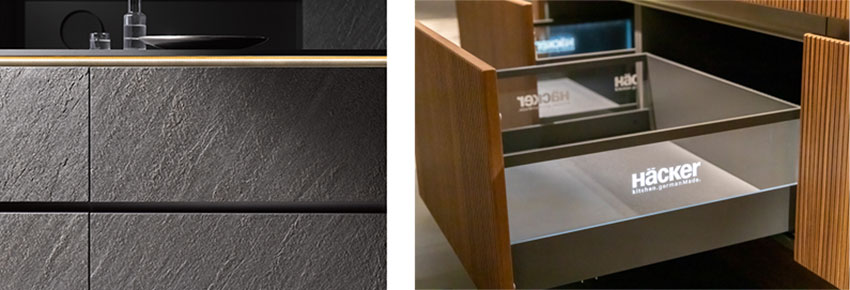
Strips of LED lighting in unexpected places—along a countertop base, or inside drawers—add style and safety to kitchen spaces.
Task Lighting provides focused light on specific areas of the kitchen, such as counters and islands. Task lighting can be provided by a variety of sources, such as pendant lights, under-cabinet lights, and track lighting.
Under-cabinet lighting comes in a variety of types, including LED strip lights, puck lights, and florescent tube lights and can impact the way a kitchen looks and feels. Under-cabinet lighting is not a replacement for ceiling-mounted light fixtures. The ceiling lights will still be necessary for general illumination, but the under-cabinet lights will provide the focused light needed for work surfaces.
Accent Lighting highlights specific areas or features of the kitchen, such as a decorative backsplash or a piece of artwork. Accent lighting can be provided by a variety of sources, such as recessed spotlights, track lighting, or even LED strip lights.
Toe kick lights, or plinth lights, can add an extra level of warmth and practicality to the space. These lights are usually LED strips that are installed at the base of the cabinets and can be activated by sensors for convenience and safety.
Channel lighting is installed in a channel that runs along the underside of a worktop. This type of lighting is appropriate for workspaces that are lacking in natural light or have dark corners.
In-cabinet lighting improves the look and functionality of a kitchen. Incorporating LED spotlights or LED strip lights within each framed or frameless glass cabinets highlights the crockery, glassware, and other decorative items. The specification of glass shelves allows light to filter and travel to the bottom shelf. Added dimmers control the intensity of light and create a soothing ambiance in the kitchen.
Open shelves can be illuminated with LED spotlights to highlight key features and favorite décor and to create a warm and inviting space.
Ambient Lighting provides a general, overall illumination to the entire kitchen. It can be provided by a variety of sources, such as ceiling lights, recessed lights, or natural light from windows.

While clutter is hidden thanks to shelving and drawer strategies, LED lighting strips the recessed display shelves emphasize the occupant’s treasures.
Tips for Equipping Small Spaces
If the floor plan offers limited kitchen space, space-efficient ideas are key. An obvious way to make the most of space in the kitchen is to optimally utilize walls and cabinets. Smart inbuilt handle-less storage units and sliding doors that open upwards help create effective storage in smaller spaces, while minimizing the noise of handles and knobs, giving the space a more refined and open appearance. Linear concealed appliances such as dishwashers, coffee machines, or touch-to-open warming drawers help create uniformity making a space seem bigger than it might be. Slimmer units of ovens and fridges without protrusions provide a complete solution for seamless movement.
OPTIONS FOR DRAWER AND CABINET ORGANIZATION
A kitchen that is intelligently laid out and properly lit will not function to its highest capacity unless cabinets and drawers are equipped with advanced organizational features. Gone are the days when it’s acceptable to deliver an upscale kitchen with drawers and cabinets bereft of any organizational features. That sent this message to the client: “I made the kitchen look good; you figure out the rest.” Today’s homeowners want life to be streamlined and simplified with integrated storage solutions, not burdened by the hassle of undefined cabinets and drawers.
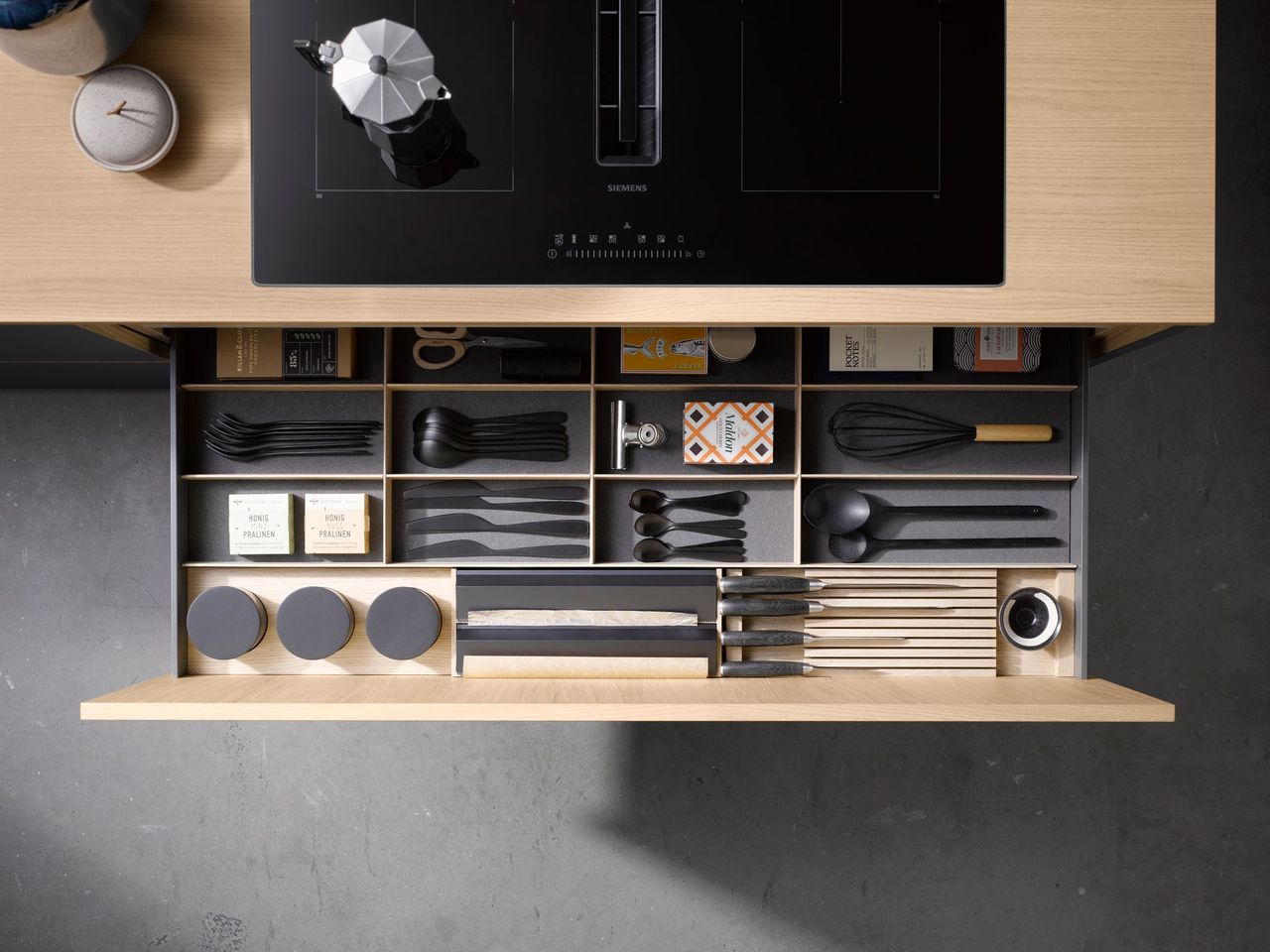
Drawer dividers.
To design a kitchen with maximum functionality, focus on the homeowner's specific needs. Probing questions can guide the specification of drawer and cabinet organization features.
"When clients first walk in the door, they often have a vision of what their kitchen should look like, but rarely do they have a full sense of what it could feel like," said Maya Nair, Premium Partner, Häcker Kitchens, Greenwich, Connecticut. "Transforming not just the aesthetics of the space but also the functionality gives us the opportunity to introduce new, innovative, and genuinely useful features to clients that they didn't expect and usually don't have with their current kitchen. Our goal is always to make it easier for clients to live in their own home."
Questions to ask homeowners include:
- Do you buy in bulk at big box stores and do you need space for those items?
- Do you buy cases of water?
- Are there small children for which child-proof locks are required?
- What infrequently used appliances would you like to get off the counter?
- Would you like functional access to corner cabinets?
- Would you prefer dinnerware in drawers rather than overhead cabinets?
- What is the extent of your cutlery and do you need organization for it?
- What utensils do you need handy and near the cooktop?
- Would you like a pull-out pantry near the stove for oils and spices?
- What is the extent of your wine collection?
- Would you like to eschew upper cabinets for an open feeling or to leave space for a window?
- Would you like a coordinating sideboard in adjacent living space for a cohesive feeling?
- What is the extent of your under-sink cleaning products?
- Is there space in an adjacent laundry room for more pantry storage units?
- Do you collect recycling and need space for that?
- Do you need special storage solutions for unusual appliances, utensils or food items?
When these questions are asked and answered, and thus guide the kitchen program, the client ends up with a kitchen that feels custom made for them and their families.
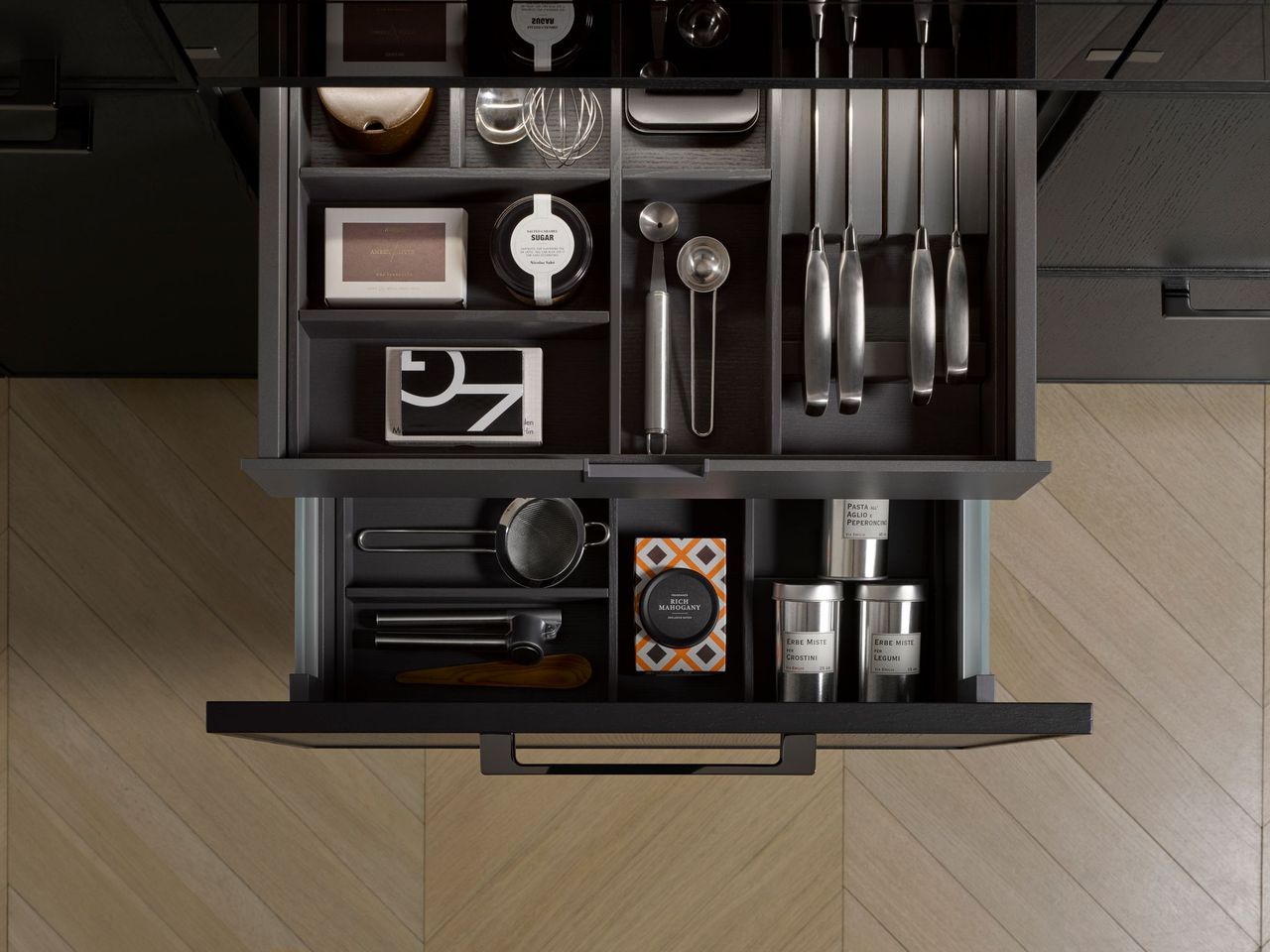
Drawer with flexible dividers.
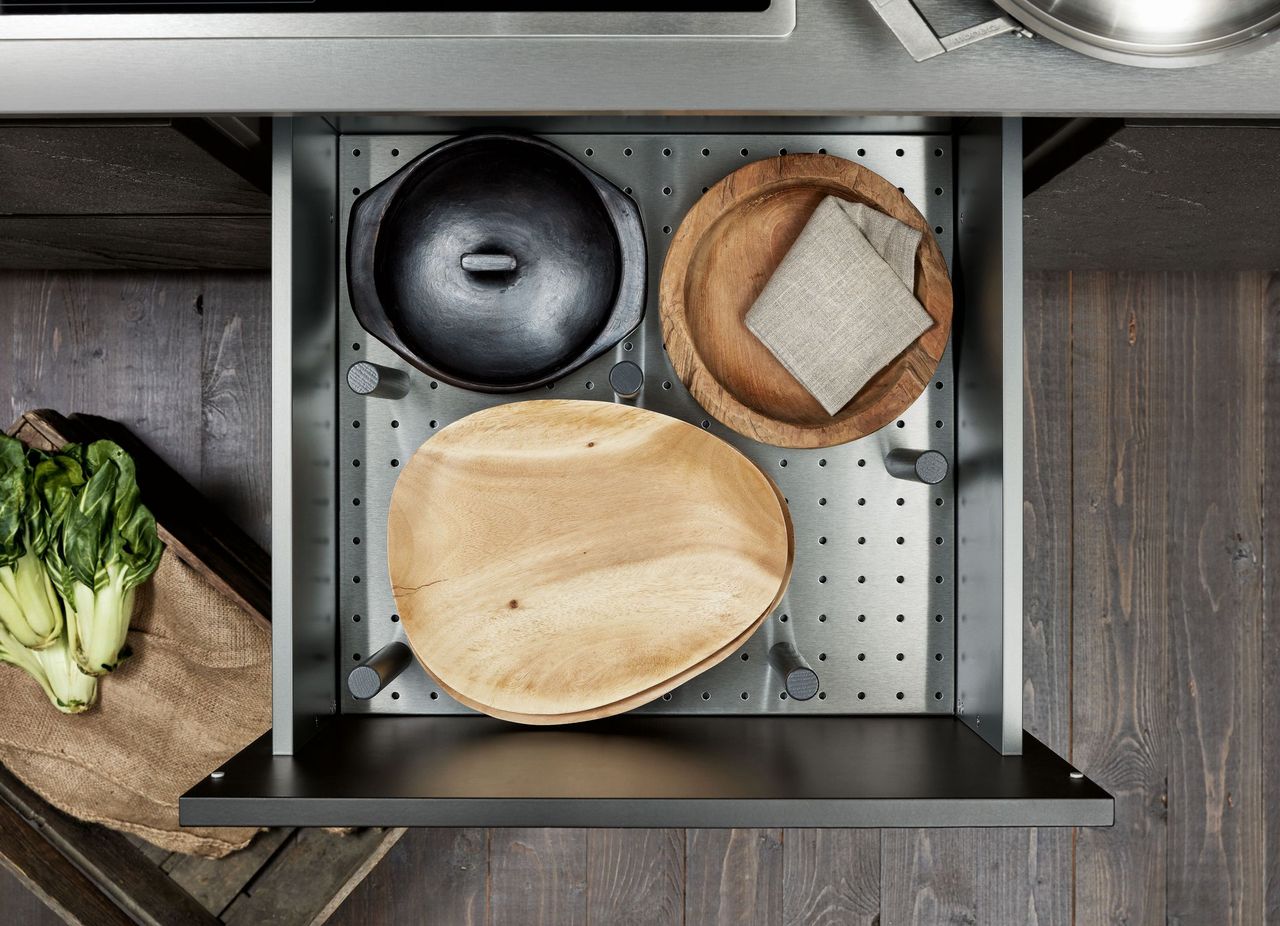
Wooden bars for rattle-free drawers.

Shallow drawer under cooktop.
Here are some solutions:
Drawers
Order in the drawers equals order in the kitchen. These innovative drawer storage solutions can be considered.
Integrated Drawers for Dinnerware and Cutlery
In high-end kitchens, storing dinnerware in drawers rather than overhead cabinets has become de rigueur. Elevating that trend is a cutlery drawer integrated into the dish drawer.
Flexible Knife and Cutlery Arrangement
A cutlery insert is practical and hygienic. Separators can be removed to adjust the cross dividers as needed and the compartments can be cleaned easily. The separators can then simply be pushed back on. A cutlery insert may also have anti-slip properties that prevents sharp cutlery damage to the end walls and also offers high hygiene standards.
Narrow Utensil Drawer
Often the most important drawer is the one under the cooktop. Whether it’s cooking spoons or spatula, everything must be at hand quickly. However, the dimensions of many cooktops offer no room for a drawer. This is where the special drawer with a flatter structure makes sense. The practical layout can be rounded off by a narrow cutlery insert.
Flexible Drawers with Transverse and Longitudinal Dividers
Drawers with dividers allow clients to combine the compartments as they wish depending on their taste and needs. As those needs change, the placement of the dividers change, keeping items in order rather than in a jumble of chaos.
Rattle-Free Drawers
Some clients are more bothered by rattling sounds than others. If a rattle-free kitchen is a priority, a dinnerware drawer with moveable wooden bars keeps stacks of items in place. This means no rattling and no shifting of items. These inserts ensure safe and stable storage for easily-chipped fine china. With this system, pots no longer bang against each other. The solid wooden bars can be moved for a customized storage solution.
Drawer Storage for Heavy Items
In general, pull-outs are ideal for storage of heavy and bulky dishes. A drawer makes heavier items easier to access than they would be on a static shelf.
Bottle Storage
A bottle rack can be integrated into a storage drawer. This keeps bottles from knocking into each other and eliminates annoying rattling sounds that disturb acoustic peace.
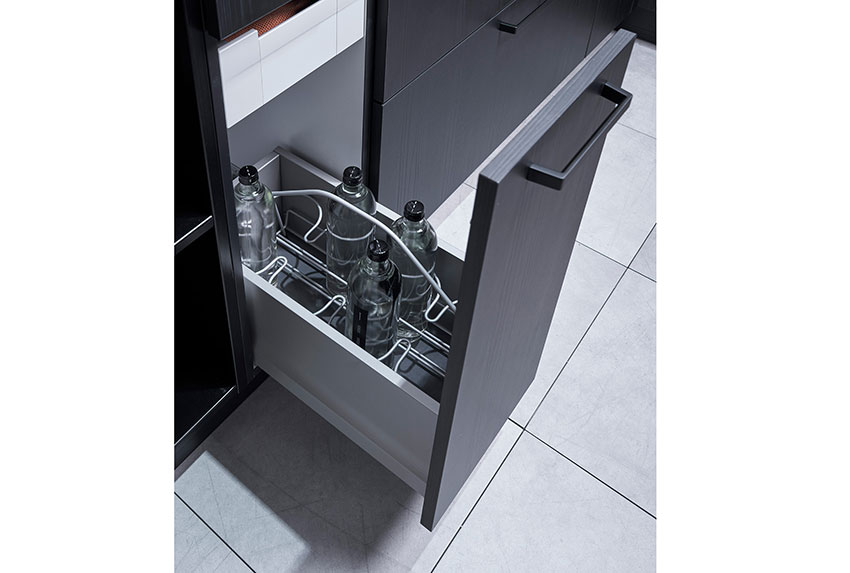
Bottle storage rack.
Baguette and Bread Storage
Everybody loves baguettes, but where do you store them? Not much thought has been given to this topic . . . until now. A combination drawer insert with a canvas tote and wire shelves can be used for bread and baguettes, or any other items.
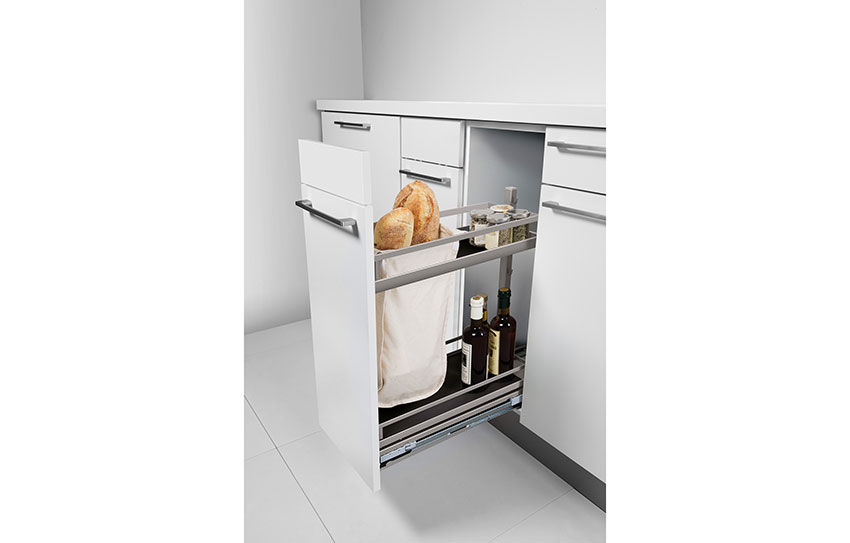
Canvas hanging bag for baguettes.
Child Safety Drawers
Child safety locks prevent the drawer from opening in the conventional way. Ideally child-proof locks are integrated into the cabinet design rather than being an add-on feature. In this case, a small trick allows effort-less opening: just pull the hoop at the bottom of the drawer. This brings safety for small children and convenient handling for the grown-ups. A child safety drawer should be indistinguishable from a conventional drawer.
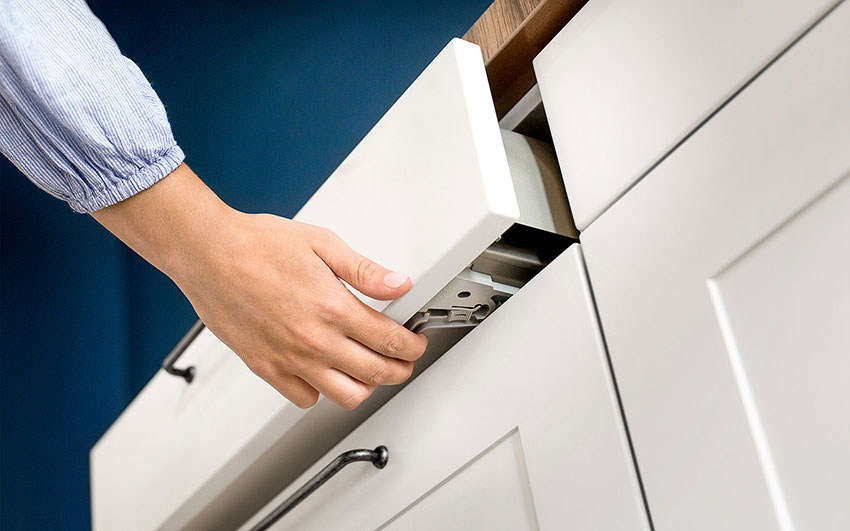
Built-in child safety locks.
Cabinets and Shelves
Order in the cabinets also equals order in the kitchen. Clients may want these innovative cabinet storage solutions.
Tall Cabinets
Over the past decade, buying items in bulk has become the norm and looks to continue. But kitchen storage design has not kept up with this trend. It’s not uncommon to find laundry rooms stacked with large cases of goods because there is no place to store them. This includes cases of water. Tall cabinets are the answer, ready to hold the bounty from big box stores. For more storage, tandem tall cabinets offer double the capacity. They provide impressive overview, extremely high storage capacity, and great accessibility thanks to intelligent door shelves.
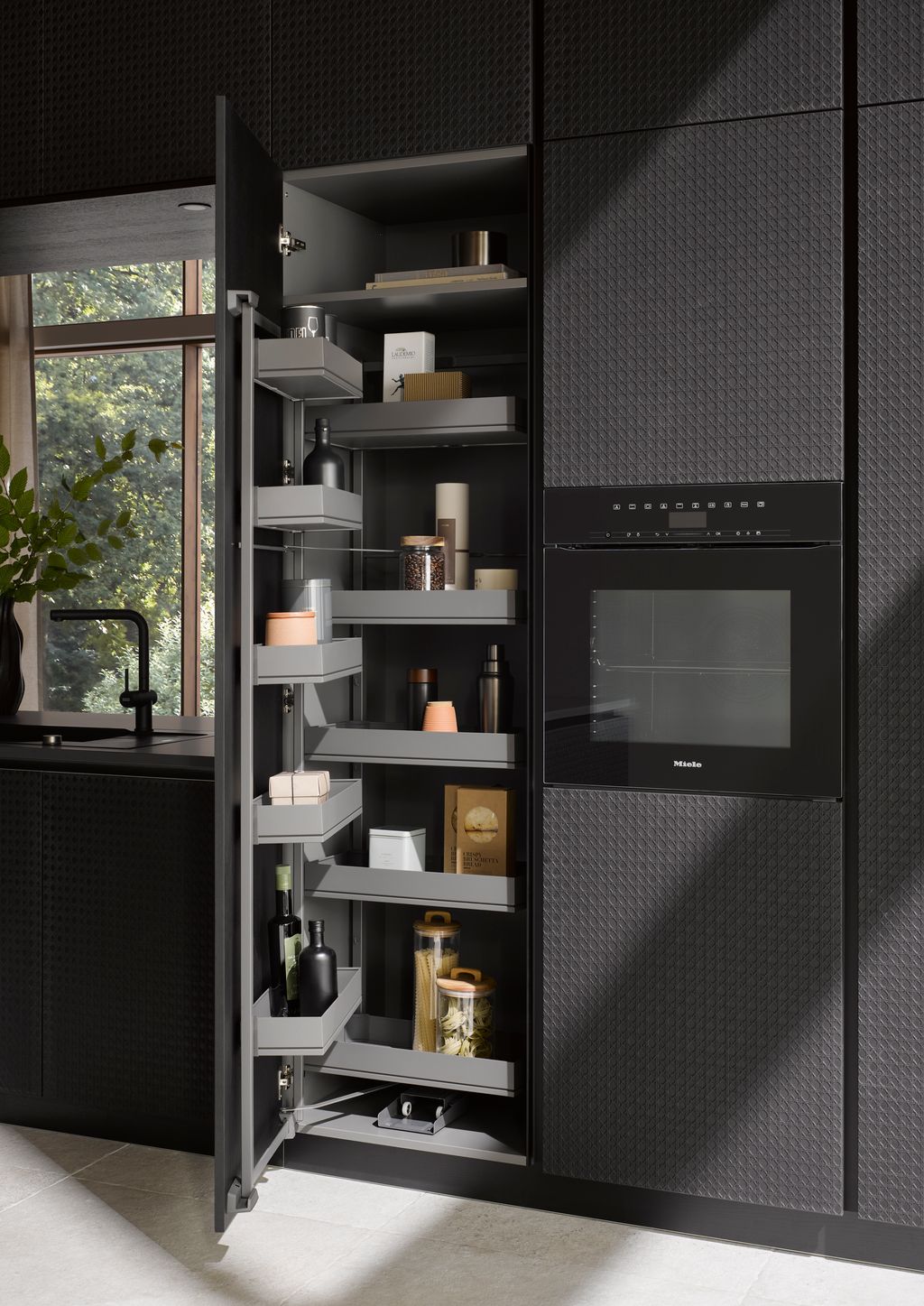
Tall pantry cabinet.
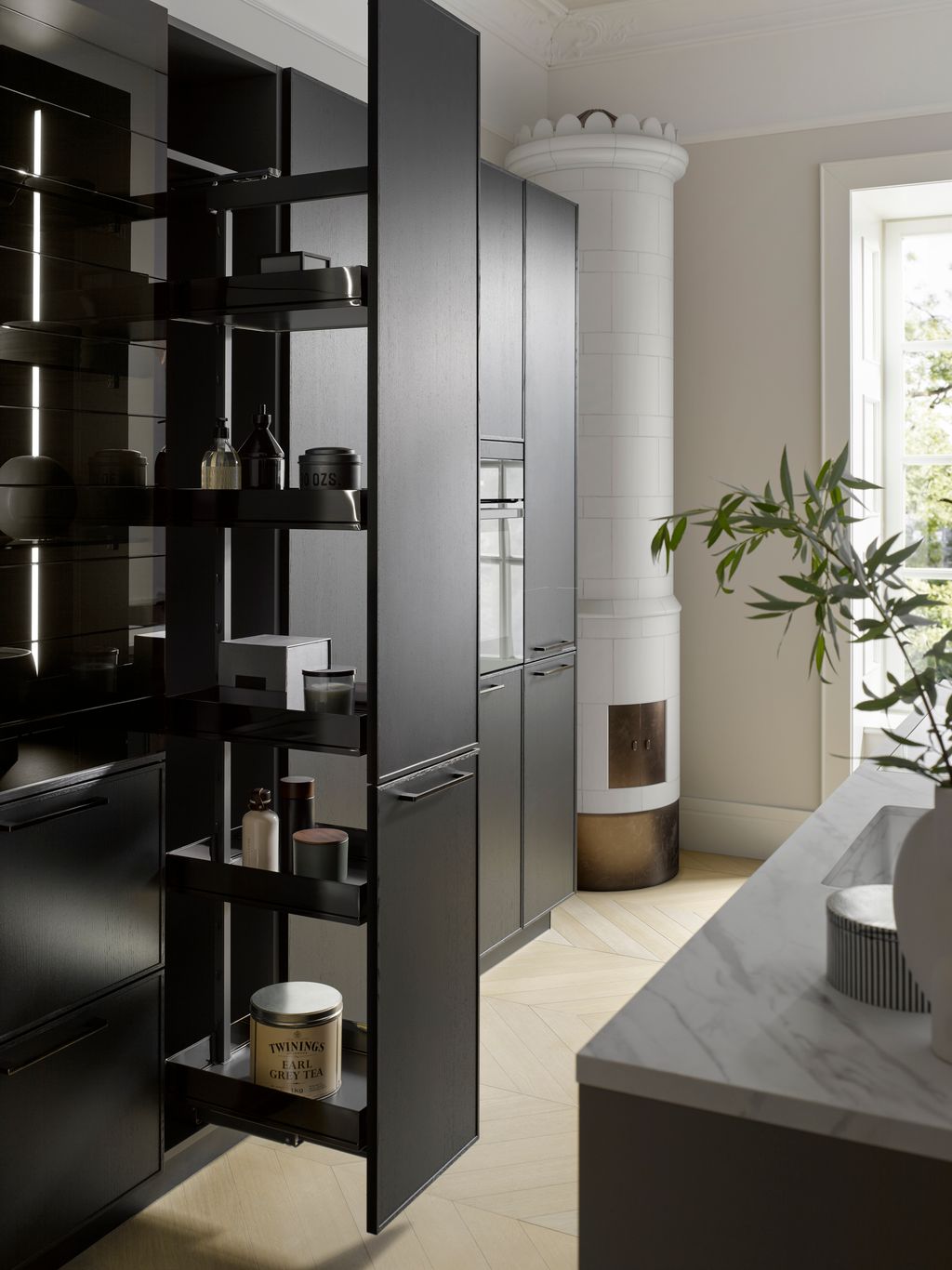
Pull-out pantry unit.
Tall Pantry Pull-Out Cabinets
A pull-out pantry cabinet keeps supplies convenient, highly visible, and close at hand. Occupants can see quickly what is on the shelves, thus items do not get forgotten in the dark recesses of stationary cabinets.

Lift-up upper cabinet doors.
Overhead Cabinet Doors
Cabinet doors that lift up rather than out add a sense of refinement to any kitchen and make what’s inside the cabinet more accessible.
Open Shelving
When clutter is eliminated, the kitchen is ready for some intentionally visible items and open shelving makes that possible. These may be family photographs, treasured art pieces, travel tchotchkes, or other items. Shelves that are lighted provide the most impact.
Trash/Recycling
The cabinet containing the waste basket is likely the most used cabinet in the kitchen. How many times does a client use the waste bin in a day? But it’s often located in an inconvenient place.
We’ve all had the experience of cooking in the kitchen, cutting vegetables on the countertop, and needing to reach the waste bin quickly and easily. But it is underneath the sink, where perhaps someone else is busy washing the dishes. Designing the waste system under the sink is common, but impractical. It makes more sense to position the waste system directly under the kitchen counter. Potato peels, onion peels, and other household waste can be easily and tidily be pushed directly into the pull-out bin. This is also a good placement for the recycling storage.
Fire Extinguisher/Safety Kit
Domestic fires usually start in the kitchen. Considering the high temperatures when cooking and baking, it is not surprising that things can go wrong. A fire extinguisher is good to have on hand. But where should it be kept? A safety kit and fire extinguisher integrated into a kitchen cabinet helps ensure a safe cooking and baking experience.
FINDING HIDDEN OR UNDERUSED STORAGE SPACE
Nearly everyone wants more storage space in the kitchen. This is doubly true when the kitchen is small. The solution is to find and use hidden and unused space. Here are some ideas.
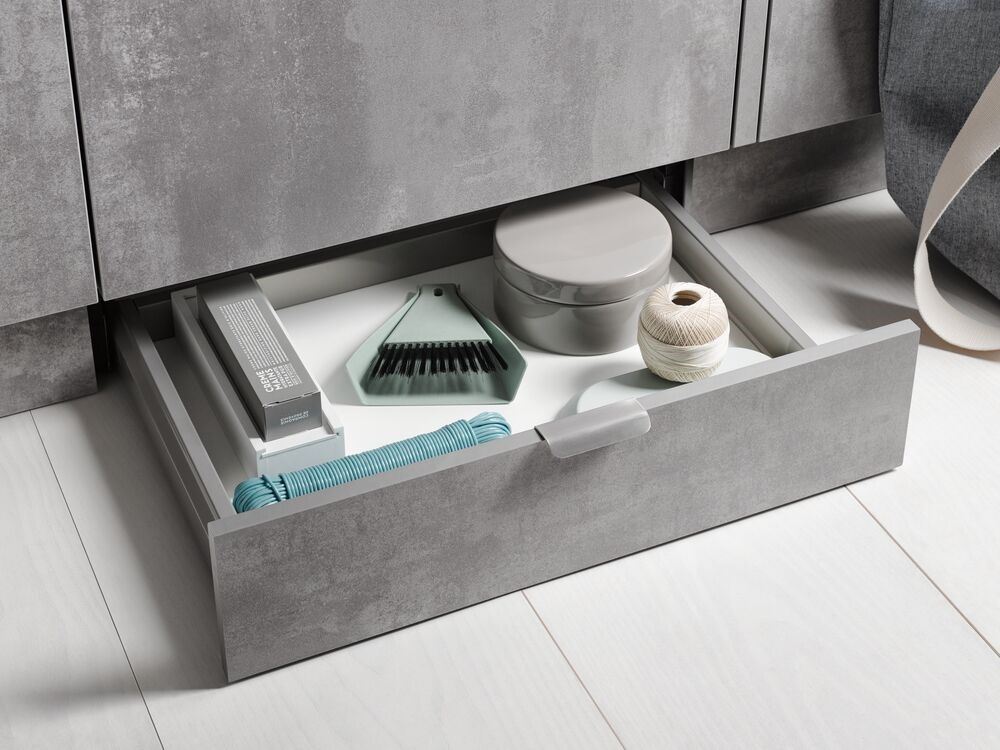
Hidden storage behind kickplate.
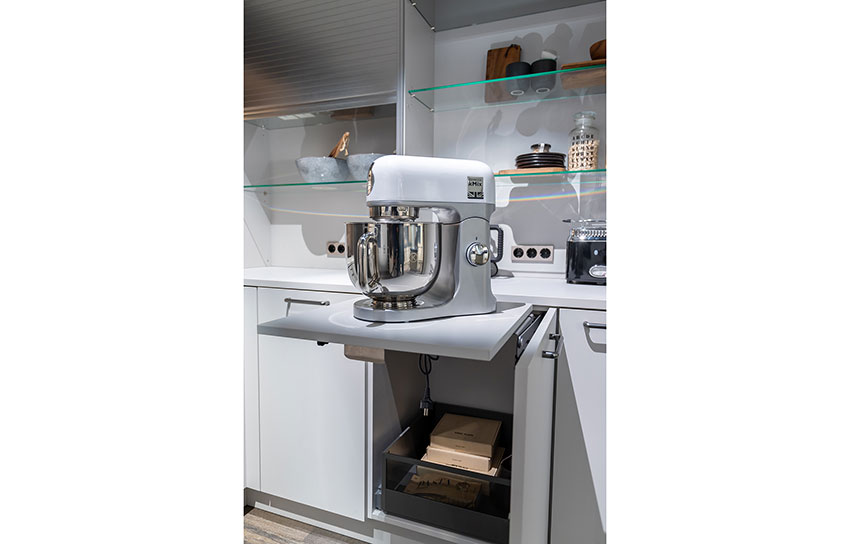
A place for a heavy mixer.
Kickplate Drawers
Of course, we need recessed kickplates so we can stand properly at a counter. But what of the space beyond the cabinet? Kickplate drawers offer storage space that was formerly untapped.
Pull-Out Mixer Shelf
A familiar dilemma for home cooks is the desire to use large appliances such as a pastry mixer, without the mixer sitting on the countertop all the time. Complicating matters is the weight of the appliance, which makes hauling it in and out of a cabinet difficult or impossible. A pullout shelf allows this large and heavy mixer to be easily extracted from the cabinet, used, and then stowed away for an uncluttered look.
Corner Cabinet Solutions
Nearly every kitchen is burdened by a deep corner cabinet that is hard to access. Either the cabinet doesn’t get used because retrieving items is too much of a hassle. Or the occupant uses the cabinet, but with great difficulty. Here are some solutions
Le Mans Corner Shelf
One solution is a corner shelf unit with a swiveling extension (sometimes called a Le Mans shelf because its shape is suggestive of the famous racetrack) that optimizes corner cabinet space. Adjustable trays/shelves accommodate a variety of pot sizes.
Electronically Raised Corner Shelf
Inner cabinet corners create spaces that are notoriously hard to use to their best advantage. One solution is an electronically controlled platform that lowers kitchen appliances or pots and pans into an unused corner of the cabinet, and then raises them for use.
Pull-Out Shelf and Roller-Shutter Door
Another corner solution is a cabinet with a pull-out shelf and a roller-shutter door. The pull-out shelf is modern and practical at the same time. The roller-shutter cupboard in the kitchen is classy and neat when closed, creating an easily accessible shelf when opened.
Conclusion
As life gets more complicated, people increasingly want their homes to be refuges of peace and order. That cannot happen when the space is cluttered. The designer can provide solutions to this problem by suggesting and specifying the variety of innovative organizational products coming on the market. With intelligent design decisions, based on client preferences to fit the way they live, the kitchen will not only look and feel beautiful, but will become the highly functional and serene space the owners need for their health, safety, and well-being.
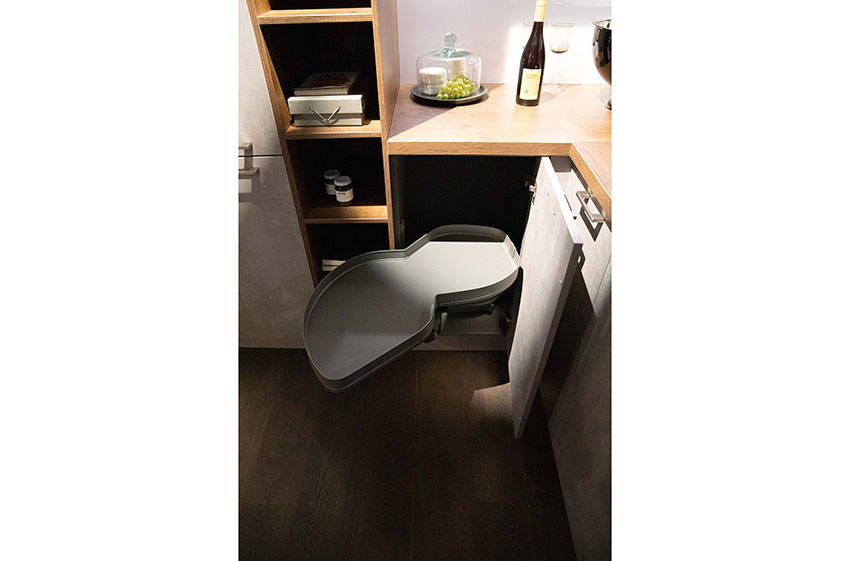
Le Mans shelf system.
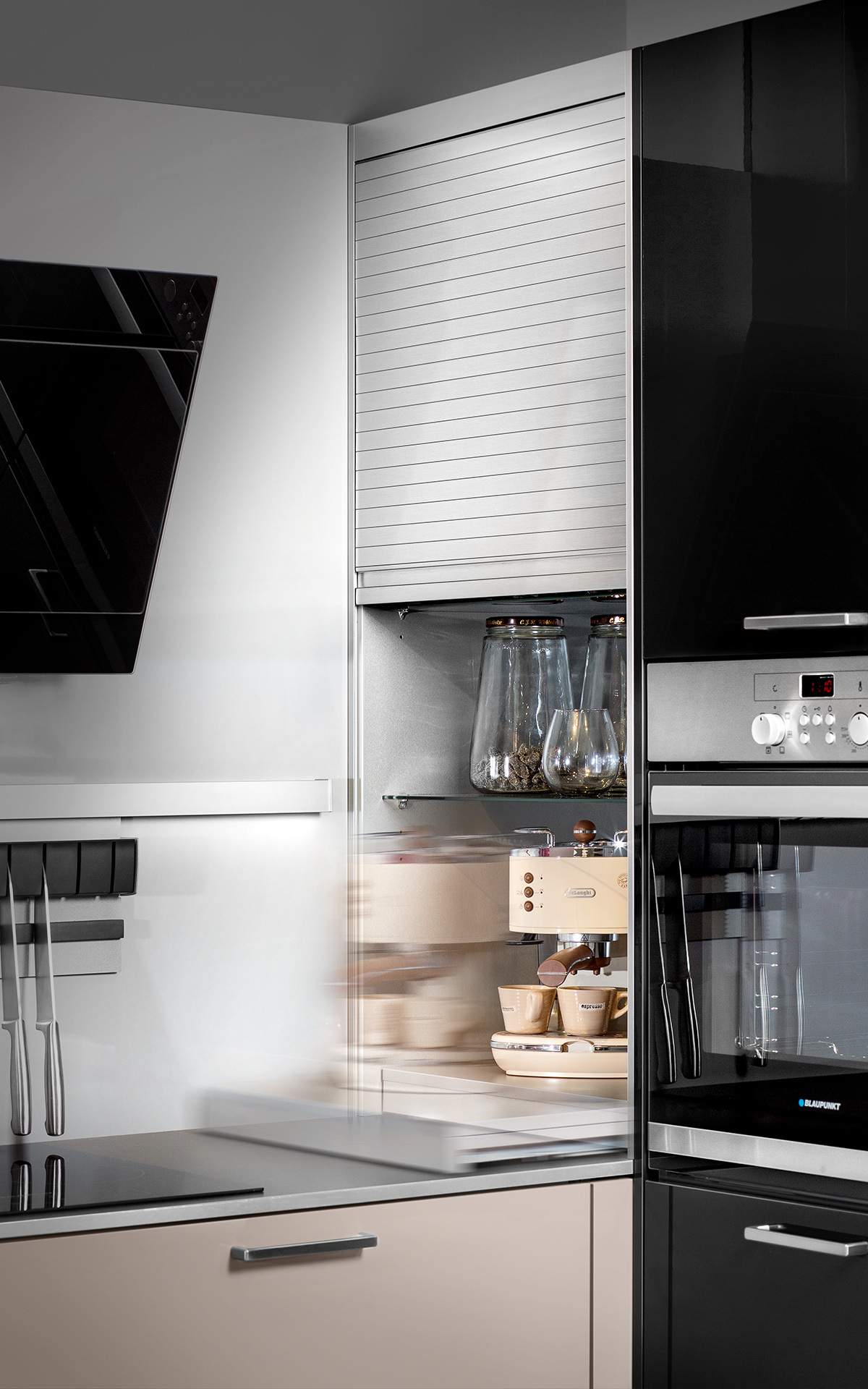
Pull-out corner shelf.
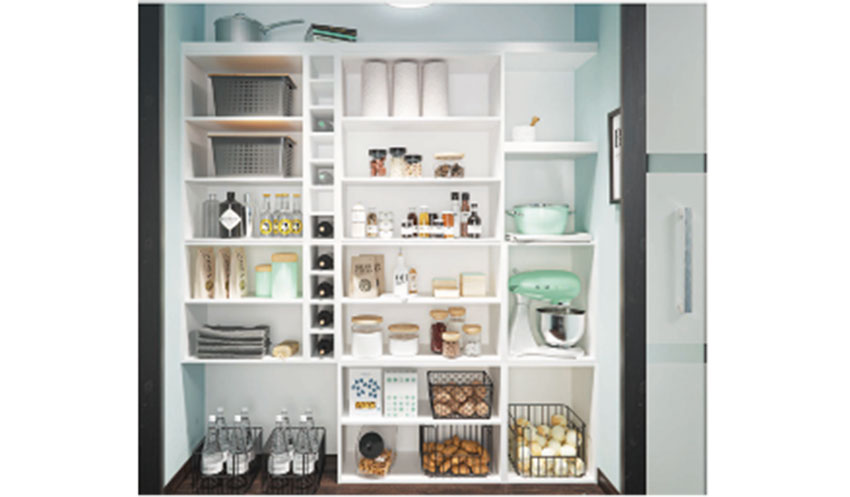
Kitchen storage in utility room.
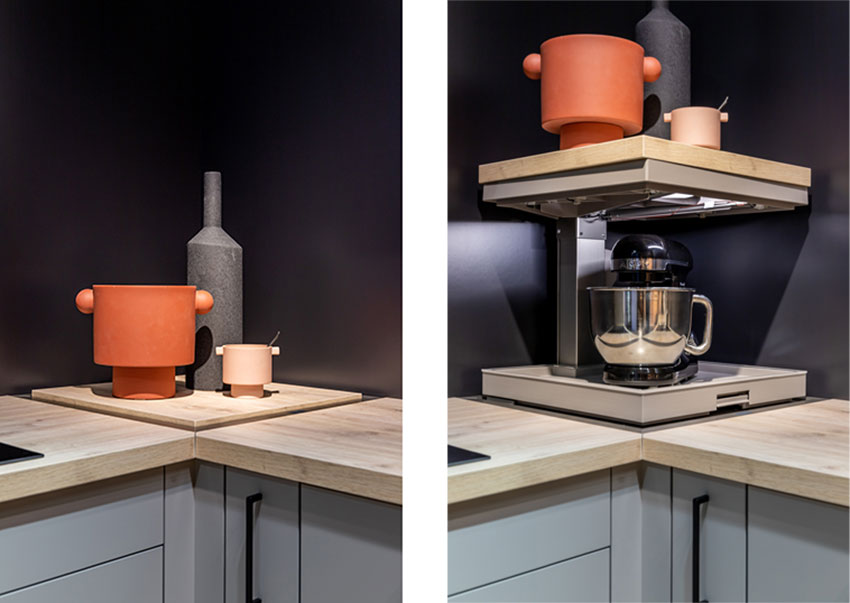
Electronic corner shelf.

Architecturally compatible kitchen and sideboard.
Under-Sink Drawer Organizer
In most homes, the space under the sink is not used wisely. Intelligent pull-out shelves with safety hoops wrap around the plumbing and ensure that the drain is not damaged.
All cleaning agents can be stored clearly and within easy reach in a detergent pull-out basket. The pull-out can be removed and taken directly to the cleaning location. The compartments and baskets can be adjusted to the client’s sorting preferences with flexible separators.
Utility Room (Back-Up Kitchen)
Trending now is a back-up kitchen, especially needed in homes without basements. A utility room next to the kitchen is increasingly used as a back-up kitchen. Utility cupboards let it blend in with the kitchen.
Sideboards
With the trend toward merging the kitchen and living spaces, clients look for ways to harmonize the two areas. Some kitchen companies offer sideboards with the same aesthetic as the kitchen cabinets to allow the two rooms to flow together seamlessly.
END NOTES
1Ambardekar, Nayana MD (medical reviewer). “How Clutter Can Affect Your Health.” WebMD. 7 March 2021. Web. 14 March 2023
2Swanson, Helena; Ferrari, Joseph. “Older Adults and Clutter: Age Differences in Clutter Impact, Psychological Home, and Subjective Well-Being.” Behavioral Sciences. 3 May 2022. Web. 14 March 2023.
3“NKBA Releases Its 2023 Trend Report.” NKBA/KBIS. 19 October 2022. Web. 14 March 2023.
Kathy Price-Robinson is a nationally known writer focusing on building and architecture. Her award-winning remodeling series ran 13 years in the Los Angeles Times. She has written for dozens of publications in the design and building industry and developed more than 100 continuing education courses.



